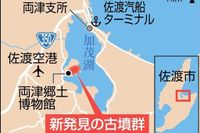In a remarkable archaeological breakthrough, two keyhole-shaped tombs, believed to date back to the early Kofun period in the 4th century, have been discovered in Sado City, Japan. This finding, made on April 24, 2025, marks the first time such tombs have been identified on Sado Island, a significant addition to the island's historical narrative.
Located on the hills surrounding Lake Kamo, these tombs are approximately 30 meters in length, with the rear circular section standing about 2 meters high and the front rectangular section about 1 meter high. This discovery positions Sado as home to the northernmost keyhole-shaped tombs along the Sea of Japan coast, surpassing the previously known northernmost tomb, the Kakuda Hama Myokoji Yama Kofun, found in Niigata City in 2020.
Experts have suggested that the presence of these tombs indicates a strong relationship with the Yamato government, which was central to the political landscape of ancient Japan. The discovery was announced by a group of researchers from the Niigata Prefectural Buried Cultural Property Center, highlighting the significance of this archaeological site.
Additionally, four round tombs have also been confirmed in the area, further enriching the historical context of Sado Island, which has a long history of rice cultivation believed to have begun around 2000 years ago. This agricultural practice was centered in the island's wetland region, suggesting that Sado was not only a burial site but also a thriving community with economic activities.
The Kofun period, which lasted from the 3rd to 7th centuries, is characterized by the construction of these distinctive tombs, which were often built for powerful individuals. The keyhole shape of the tombs is a notable feature, symbolizing the social hierarchy and the importance of the deceased. The new findings in Sado provide insight into the regional dynamics of power and influence during this era.
As these tombs are further studied, researchers hope to uncover more about the societal structure of ancient Sado, including its connections to the broader political entities of the time. The discovery has sparked interest among historians and archaeologists, who are eager to explore the implications of these tombs on our understanding of Japan's ancient history.
Moreover, the geographical significance of Sado Island cannot be overlooked. Historically, it served as a crucial point for maritime transport, connecting the Japanese archipelago with the Asian continent. The presence of these tombs suggests that Sado may have been a vital hub for trade and cultural exchange, further indicating its importance in the ancient world.
In recent years, Sado has gained attention for its historical sites, including the famous gold mines, which were recognized as a UNESCO World Heritage site. The island's rich cultural heritage continues to attract researchers and tourists alike, eager to learn about its past.
As the local community and scholars reflect on this new discovery, there is a growing sense of pride in Sado's historical significance. The tombs not only represent a physical connection to the past but also serve as a reminder of the island's role in shaping Japan's history.
In conclusion, the discovery of the two keyhole-shaped tombs in Sado City stands as a testament to the island's rich archaeological heritage. It opens new avenues for research and exploration, shedding light on the complex social and political structures of ancient Japan. As excavations continue, the historical narrative of Sado Island will undoubtedly grow richer, revealing more about the lives and legacies of those who came before us.





